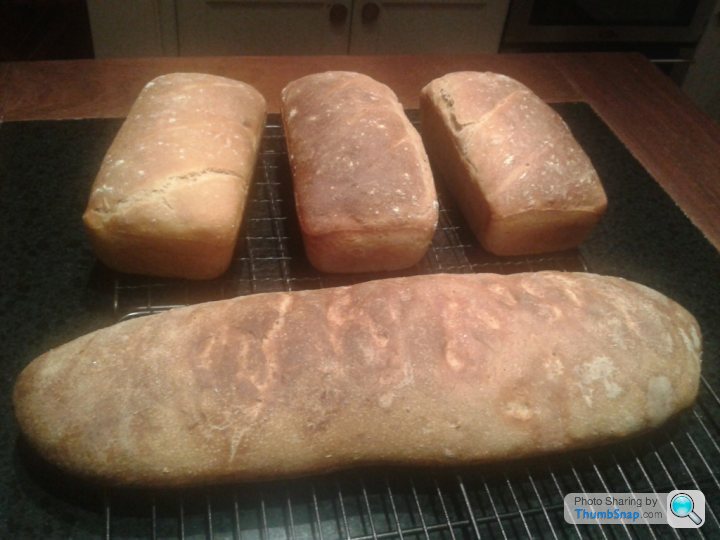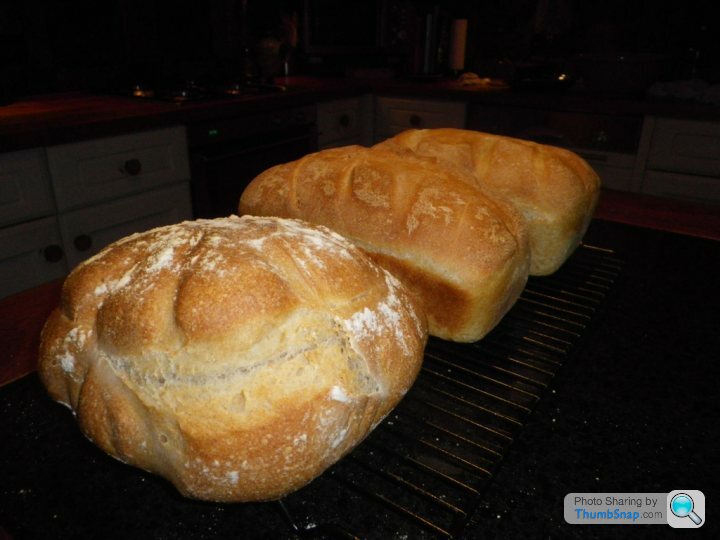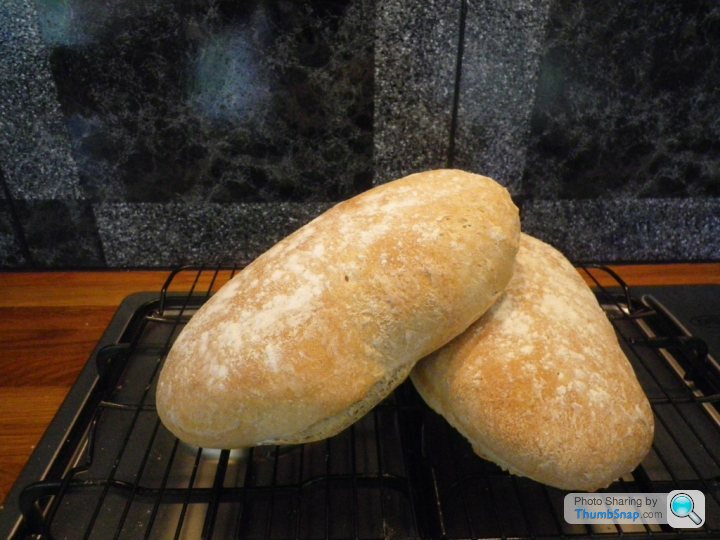Sourdough breadmaking
Discussion
grumbledoak said:
No, but I and/or the heat have killed one starter - we used half, fed half and then got only a skin-of-blue-cheese mold thing. Didn't fancy that (will post a photo if I can and you'll see what I mean).
It's replacement started explosively in the heat and has seemingly died in the fridge. Bugger.
I've found that in the hot weather its best to keep the culture in the fridge all the time and feed little and often.It's replacement started explosively in the heat and has seemingly died in the fridge. Bugger.
Back to sourdough breadmaking after a couple of weeks away in France.
Before going away, I placed a small tub of my starter in the freezer.
2 weeks later I let it defrost slowly on the worktop, then continued to feed as normal.
It was a bit slow to revive, in fact my 1st batch of sourdough bread baked with the starter last week was diabolical - so bad we ended up throwing the bread batch away and making an 'emergency' loaf using fast acting yeast!
I am pleased to report that after feeding as normal for another week, my starter returned to it's former glory and produced the usual tasty results!
Voila
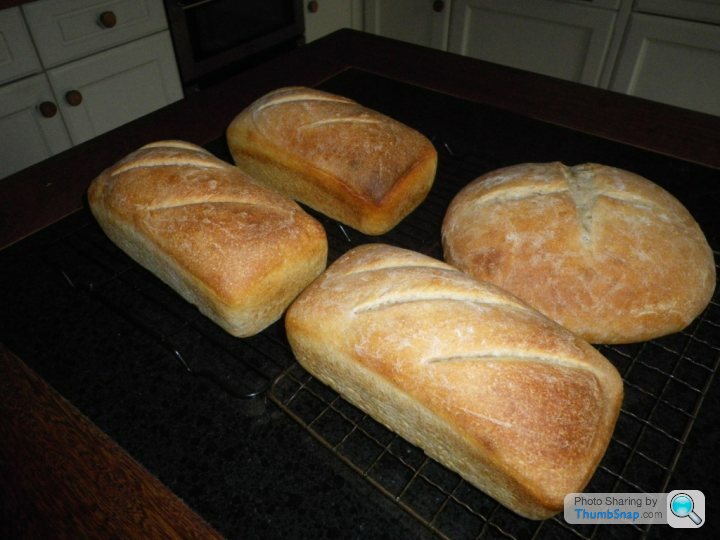
PS: Have you chaps all given up baking?
PPS: Interestingly, although there are still lots of Boulangeries where you can buy great bread in France, the mass market stuff seems to have taken a nose-dive since I was last there.
In fact in many of the French supermarkets and other general shops, the bread is no better than the commercial 'baguettes' sold in UK supermarkets!
Before going away, I placed a small tub of my starter in the freezer.
2 weeks later I let it defrost slowly on the worktop, then continued to feed as normal.
It was a bit slow to revive, in fact my 1st batch of sourdough bread baked with the starter last week was diabolical - so bad we ended up throwing the bread batch away and making an 'emergency' loaf using fast acting yeast!
I am pleased to report that after feeding as normal for another week, my starter returned to it's former glory and produced the usual tasty results!
Voila


PS: Have you chaps all given up baking?
PPS: Interestingly, although there are still lots of Boulangeries where you can buy great bread in France, the mass market stuff seems to have taken a nose-dive since I was last there.
In fact in many of the French supermarkets and other general shops, the bread is no better than the commercial 'baguettes' sold in UK supermarkets!
prand said:
Reminds me too I have a packet of organic rye flour waiting in the cupboard to kick off a starter, is it the wrong end of the year to get one going? (excuses, excuses, always excuses.....)
Get it started you wussy! Lactobacillus strain will work it's magic in any weather and turn flour and water into manna from heaven....
Not sure Paul Hollywood's methods of adding fruit are entirely right for consistantly good, Slow sourdough bread production Rizzo?
Some times it is more haste less speed?
My point being, when you use only flour and water, the wild yeasts which are naturally adapted to feed on floor will develop slowly and become dominant, and these in turn will start to produce Lactobacillus enzimes, which are both slowly fermenting and compatible with the naturally occuring wild flour yeasts, and help to produce the rich flavours in the sourdough bread.
Incidently Lactobaccillus is also thought to be good for digestion and health - look at how the yoghurt companies market it!
If on the other hand you introduce anything other than flour to the mix, (such as Paul Hollywoods fruit) whilst initial activity may well be fast and dramatic (because of the sugars), in the long term fermentation activity could be inconsistant. Think of the effect of too much sugar on hyperactive kids!
I stress again, I have been making great tasting sourdough bread every week for well over 2-years with consistantly good results, and I have never used anything other than Strong flour, Rye flour, and water.
Each week when I make a full batch of sourdough bread, (say 3 loaves and a pizza)I use virtually the whole tub of my starter, which by the time I use it is very active and will be (about) a litre in volume.
This leaves me a thin film of (about) 1/2 centimetre of starter left in the tub, which I then feed again immediately, and put back in the fridge. For the 1st day or so, the activity is slow as the starter recovers itself. It then takes about 4 or 5 days of feeding to regain its energy, and then is usually at its peak when I'm next ready to bake at the end of the week.
The proof of the pudding, last weeks bake: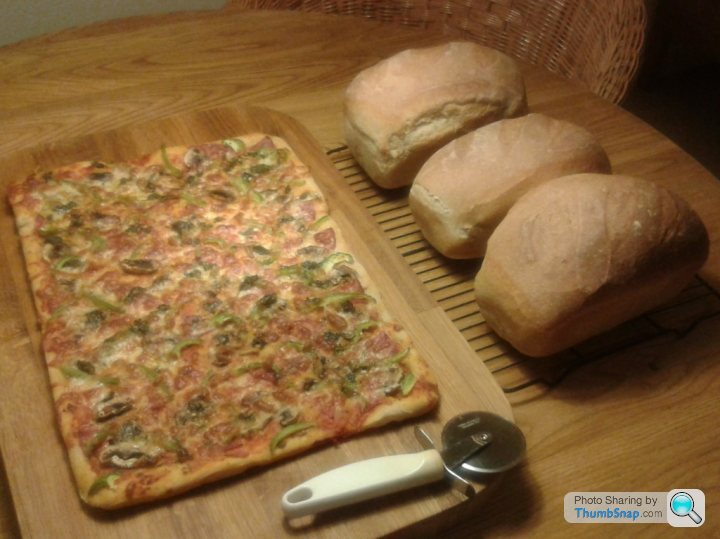
Some times it is more haste less speed?
My point being, when you use only flour and water, the wild yeasts which are naturally adapted to feed on floor will develop slowly and become dominant, and these in turn will start to produce Lactobacillus enzimes, which are both slowly fermenting and compatible with the naturally occuring wild flour yeasts, and help to produce the rich flavours in the sourdough bread.
Incidently Lactobaccillus is also thought to be good for digestion and health - look at how the yoghurt companies market it!
If on the other hand you introduce anything other than flour to the mix, (such as Paul Hollywoods fruit) whilst initial activity may well be fast and dramatic (because of the sugars), in the long term fermentation activity could be inconsistant. Think of the effect of too much sugar on hyperactive kids!
I stress again, I have been making great tasting sourdough bread every week for well over 2-years with consistantly good results, and I have never used anything other than Strong flour, Rye flour, and water.
Each week when I make a full batch of sourdough bread, (say 3 loaves and a pizza)I use virtually the whole tub of my starter, which by the time I use it is very active and will be (about) a litre in volume.
This leaves me a thin film of (about) 1/2 centimetre of starter left in the tub, which I then feed again immediately, and put back in the fridge. For the 1st day or so, the activity is slow as the starter recovers itself. It then takes about 4 or 5 days of feeding to regain its energy, and then is usually at its peak when I'm next ready to bake at the end of the week.
The proof of the pudding, last weeks bake:

Edited by Boo152 on Tuesday 5th November 16:44
PedroB said:
FiF said:
I had a real disaster with a Rye loaf some time back. Kneaded and kneaded fit to bust and still couldn't get what I felt to be a decent dough. But by then was dripping with sweat and thought enough. Left it to prove and it rose but not enough so discarded it.
Watched Hollywood do a Rye loaf the other night. Mixer and dough hook.
Git!
Thing to remember with rye flour is that it has a really low gluten content so you'll never get the same springiness as a wheat loaf. I like 100% rye but my other half won't eat it as it is a bit too dense. for a lighter rye loaf try a 60/40 rye to wheat flour ratio.Watched Hollywood do a Rye loaf the other night. Mixer and dough hook.
Git!
I only use the 50/50 mix of Rye flour/Strong white flour in my starter.
My starter is then added to a 100% mix (1.5 kilos) of strong white flour to make the bread. Results are pretty much perfect every time, i.e a full flavoured bread with a crispy crust and a light crumb.
Yes I do Cobb loaves occasionaly Rizzo - if I'm baking for a family celebration meal, I will often make a huge round loaf. But for my normal weekly bake, for convenience sake (even slicing for toast, sandwiches etc) I usually do at least 2 or 3 tin breads.
A recent bake that included a small cobb:

Water volume:
I too used excessive water when I started until I got the hang of it, and I think you may be overwatering yours if its spreading as much as you say. It will all come with practice!
The trick is to only add half your water to start with, then gradually trickle more in as you mix it in the bowl. Although my recipe stated 'about' 2 pints of water to my 1.5 k of flour, quite often I use much less than that, depending on humidity etc.
The aim is to use 'just enough' water to combine everything into a fairly stiff dough, and it should still be on the dry side when tipped out on the worktop to knead properly. You can always add tiny amounts of water as you knead to make it more pliable if its really too dry.
Hope that helps and makes sense, keep practising!
A recent bake that included a small cobb:

Water volume:
I too used excessive water when I started until I got the hang of it, and I think you may be overwatering yours if its spreading as much as you say. It will all come with practice!
The trick is to only add half your water to start with, then gradually trickle more in as you mix it in the bowl. Although my recipe stated 'about' 2 pints of water to my 1.5 k of flour, quite often I use much less than that, depending on humidity etc.
The aim is to use 'just enough' water to combine everything into a fairly stiff dough, and it should still be on the dry side when tipped out on the worktop to knead properly. You can always add tiny amounts of water as you knead to make it more pliable if its really too dry.
Hope that helps and makes sense, keep practising!
I prefer my bread on the lighter side:
My Fan assisted oven - heat up to 225c to start. Then once loaves are in, set timer for 22 mins, and turn down to 200c.
@ 22 mins, take out, and put back in oven (upside down) for a further 4mins.
So total oven time is 26mins.
Crusts are lovely and crispy and insides are perfectly cooked. I believe my oven is a hot one though - all ovens vary and yours may be running cooler than mine.
PS my loaves are 2lb in weight - if your loaf is bigger it will need longer.
My Fan assisted oven - heat up to 225c to start. Then once loaves are in, set timer for 22 mins, and turn down to 200c.
@ 22 mins, take out, and put back in oven (upside down) for a further 4mins.
So total oven time is 26mins.
Crusts are lovely and crispy and insides are perfectly cooked. I believe my oven is a hot one though - all ovens vary and yours may be running cooler than mine.
PS my loaves are 2lb in weight - if your loaf is bigger it will need longer.
Edited by Boo152 on Tuesday 19th November 20:07
Bump
Been doing some further experimenting.
(Mrs Boo prefers a more 'well done' bake, so have altered my timings a bit)
________________________________________________________________
Experiment 1.
AS above, but I now set the timer for 25 mins for the initial bake, still @ 200c (fan oven), then take out @ 25 mins, and back in oven (upside down) for a further 4 mins.
So total oven time 29mins.
If however you are not using loaf tins yours will bake quicker, so you may need to turn the oven down a tad for the last few minutes.
____________________________________________________________________
Experiment 2.
Tried a no-knead loaf - made my usual batch with 1.5kg of flour, but then at the knocking back stage, instead of shaping the whole batch into loaves, I just did 3/4 of the batch, and put the left over piece of the dough in an oiled polybag in the fridge overnight.
Next morning I just slit the polybag and tipped it gently onto the baking tray, no shaping or kneading, and let it come up to room temperature (a couple of hours) before baking for 25 mins @ 200c fan assisted.
The resulting loaf was a bit mis-shapen but it sure tasted good!
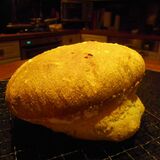

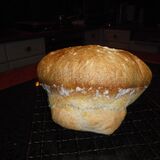
Been doing some further experimenting.
(Mrs Boo prefers a more 'well done' bake, so have altered my timings a bit)
________________________________________________________________
Experiment 1.
AS above, but I now set the timer for 25 mins for the initial bake, still @ 200c (fan oven), then take out @ 25 mins, and back in oven (upside down) for a further 4 mins.
So total oven time 29mins.
If however you are not using loaf tins yours will bake quicker, so you may need to turn the oven down a tad for the last few minutes.
____________________________________________________________________
Experiment 2.
Tried a no-knead loaf - made my usual batch with 1.5kg of flour, but then at the knocking back stage, instead of shaping the whole batch into loaves, I just did 3/4 of the batch, and put the left over piece of the dough in an oiled polybag in the fridge overnight.
Next morning I just slit the polybag and tipped it gently onto the baking tray, no shaping or kneading, and let it come up to room temperature (a couple of hours) before baking for 25 mins @ 200c fan assisted.
The resulting loaf was a bit mis-shapen but it sure tasted good!



Started a batch of sourdough bread last night – with a slightly different approach.
As some of you will know from reading the thread, my normal method is to knead well, then back in the mixing bowl, covered overnight, knock back in the morning, then into tins and prove for a couple of hours before baking. The results are consistently excellent; but it’s normally up to 12-hours from start to cutting the first slice.
However, because we finished last week’s bread yesterday, we had none for breakfast, (precious little milk either, so cereal not an option). I know, I know, 1st world problems!
So, to try a slightly different method.
Knead as normal, and then place a lump of the dough (equivalent to my standard loaf size - 2lb weight) into a well larded Swiss roll tin. Press flat with a floury hand, cover in oiled cling film, leave overnight as usual. The remainder of the dough (about 4lb in weight) I returned back to the bowl and covered as normal.
At 6.30 am I put the now risen “Swiss roll bread” in the oven. By 7am I had a perfect (flatish) loaf, and I can report that the bacon and egg butties were yummy!
Result. In the foreground you'll see what's left of the flatbread after our breakfast butties.
In the foreground you'll see what's left of the flatbread after our breakfast butties.
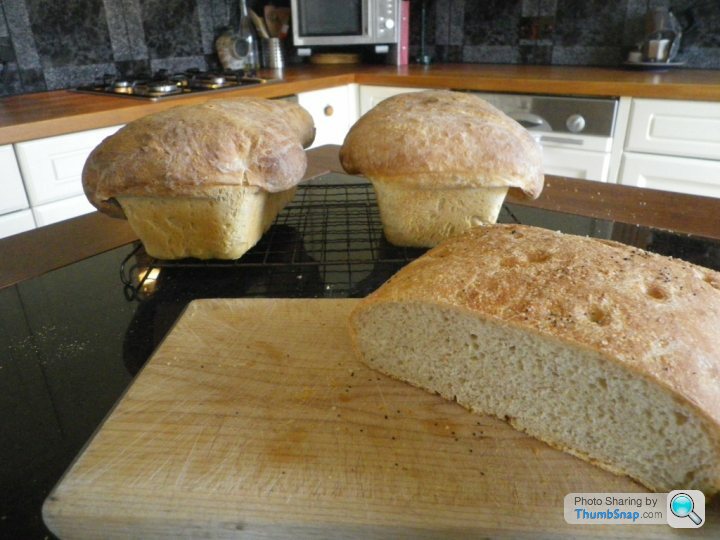
The more eagle eyed will have noticed the slightly droopy nature of the remainder of the loaves.
This happened because I divided the rest of the dough into tins this morning (as normal), but then placed in the warm to rise before baking, and stupidly left a bit too long before baking!
As the "Swiss roll no-knockback loaf" was successfull, next week I will divide whole of the batch into tins overnight, and see if the results are the same.
Get baking chaps!
As some of you will know from reading the thread, my normal method is to knead well, then back in the mixing bowl, covered overnight, knock back in the morning, then into tins and prove for a couple of hours before baking. The results are consistently excellent; but it’s normally up to 12-hours from start to cutting the first slice.
However, because we finished last week’s bread yesterday, we had none for breakfast, (precious little milk either, so cereal not an option). I know, I know, 1st world problems!
So, to try a slightly different method.
Knead as normal, and then place a lump of the dough (equivalent to my standard loaf size - 2lb weight) into a well larded Swiss roll tin. Press flat with a floury hand, cover in oiled cling film, leave overnight as usual. The remainder of the dough (about 4lb in weight) I returned back to the bowl and covered as normal.
At 6.30 am I put the now risen “Swiss roll bread” in the oven. By 7am I had a perfect (flatish) loaf, and I can report that the bacon and egg butties were yummy!
Result.
 In the foreground you'll see what's left of the flatbread after our breakfast butties.
In the foreground you'll see what's left of the flatbread after our breakfast butties.
The more eagle eyed will have noticed the slightly droopy nature of the remainder of the loaves.

This happened because I divided the rest of the dough into tins this morning (as normal), but then placed in the warm to rise before baking, and stupidly left a bit too long before baking!
As the "Swiss roll no-knockback loaf" was successfull, next week I will divide whole of the batch into tins overnight, and see if the results are the same.
Get baking chaps!
Tuesday mini-bake:

Just a reminder of how simple good sourdough bread is to make. You dont need any special equipment and the ingredients are available from your local supermarket. For the above two loaves my recipe is as follows:
Ingredients: 750 grammes of Aldi Strong white flour; 2 level teaspoons cooking salt; 1 tablespoon of rapeseed oil; (about) 1/4 litre of active sourdough starter; and (up to) 1/2 litre water. Method. Chuck all the ingredients (but just half the water) into a large mixing bowl. Stir with a big spoon until thoroughly mixed. Start kneading in the bowl, gradually trickling more water in as you knead until a soft pliable dough is formed, but try to keep on the dry side rather than sticky. After about 5 minutes tip the dough onto a lighly floured worktop and continue to knead and stretch the dough about until it will form into a soft ball without collapsing. You may not need all the water. Chuck the ball of dough back in the bowl. Cover with oiled clingfilm and leave for about 5/6 hours; the rise time will depend on kitchen room temperature (I leave mine overnite), but it can be a pain in the summer getting up at 4am!
When the dough has at least doubled its original size, take off the clingfilm and put to one side; knock back (quickly slap) the dough down in the bowl, tip out again onto your floured worktop; divide into 2, and quickly shape into balls. Do not over handle. Place the dough balls on a well greased oven tray, slash the tops with a sharp knife, cover again with the oiled cling film, and leave to prove for another hour or so until they again double in size. Oven on at 200c (fan) wait until temp is reached and place the loves in the oven for about 24 minutes. Take out after 24 minutes and tap the tops, they should sound hollow and should be golden brown. If not dark enough for your taste put back in for a couple more minutes.
Place on a rack to cool(if you can wait)for about an hour - slice off your first crust, and spread with best butter. Enjoy.
Get baking chaps - it really is that easy!

Just a reminder of how simple good sourdough bread is to make. You dont need any special equipment and the ingredients are available from your local supermarket. For the above two loaves my recipe is as follows:
Ingredients: 750 grammes of Aldi Strong white flour; 2 level teaspoons cooking salt; 1 tablespoon of rapeseed oil; (about) 1/4 litre of active sourdough starter; and (up to) 1/2 litre water. Method. Chuck all the ingredients (but just half the water) into a large mixing bowl. Stir with a big spoon until thoroughly mixed. Start kneading in the bowl, gradually trickling more water in as you knead until a soft pliable dough is formed, but try to keep on the dry side rather than sticky. After about 5 minutes tip the dough onto a lighly floured worktop and continue to knead and stretch the dough about until it will form into a soft ball without collapsing. You may not need all the water. Chuck the ball of dough back in the bowl. Cover with oiled clingfilm and leave for about 5/6 hours; the rise time will depend on kitchen room temperature (I leave mine overnite), but it can be a pain in the summer getting up at 4am!
When the dough has at least doubled its original size, take off the clingfilm and put to one side; knock back (quickly slap) the dough down in the bowl, tip out again onto your floured worktop; divide into 2, and quickly shape into balls. Do not over handle. Place the dough balls on a well greased oven tray, slash the tops with a sharp knife, cover again with the oiled cling film, and leave to prove for another hour or so until they again double in size. Oven on at 200c (fan) wait until temp is reached and place the loves in the oven for about 24 minutes. Take out after 24 minutes and tap the tops, they should sound hollow and should be golden brown. If not dark enough for your taste put back in for a couple more minutes.
Place on a rack to cool(if you can wait)for about an hour - slice off your first crust, and spread with best butter. Enjoy.
Get baking chaps - it really is that easy!

Yes, I agree with Mrs P you are probably overproving.
Bear in mind I probably make larger quantities than most: i.e. 1.5kg flour, almost 1 1itre starter, around 1 litre water etc, and a big batch takes a bit longer to prove than a small one....
My timings:
I usually start my bread mix before I got to bed. All of the flour, oil and salt in. All of the starter in
Half the water in. Then stir in the bowl with a big wooden spoon, gradually trickling more water in until most of the dry flour is mixed (I dont always need all of the water, depending on humidity etc, but the amount you will require in yours will come with practice). I then knead the mix in the bowl for a few minutes before turning out on the floured worktop, and kneading for about another 10 minutes, adding very small amounts of flour as required until it no longer sticks to my hands or the worktop.
I then leave overnight to rise enough to be ready for knocking back and shaping (bit tricky in the summer cos it could takes only 4/5 hours before it's escaping out the bowl, so I have to be prepared to check it around 5am. Winter is a bit more relaxed as it can take 6 or 7 hours to be ready for shaping.
So once shaped and on the trays, depending on kitchen temperature, it will have risen back up and be ready for the oven in between 2 and 4 hours.
So thats total proving/rising time of between 7 and 11 hours depending on kitchen temperature/time of year. Add on (say) another hour for the mixing, tin greasing, oven time, etc gives you a max time of 12 hours from starting off to turning out the finished loaves. And if you are working with smaller quantities, as mentioned earlier, 1st prove times will be quicker.
PS if I'm making pizza, at the point when I shape the loaves, I hive off a lump of the dough in an oiled polybag in the fridge, and then take it out of the fridge about an hour before we want the pizza, flatten it out, add the sauce, filling, cheese etc, then once its back up to room temp and risen its ready to bake. Pizzas only take about 10 minutes to bake. Hope this helps!
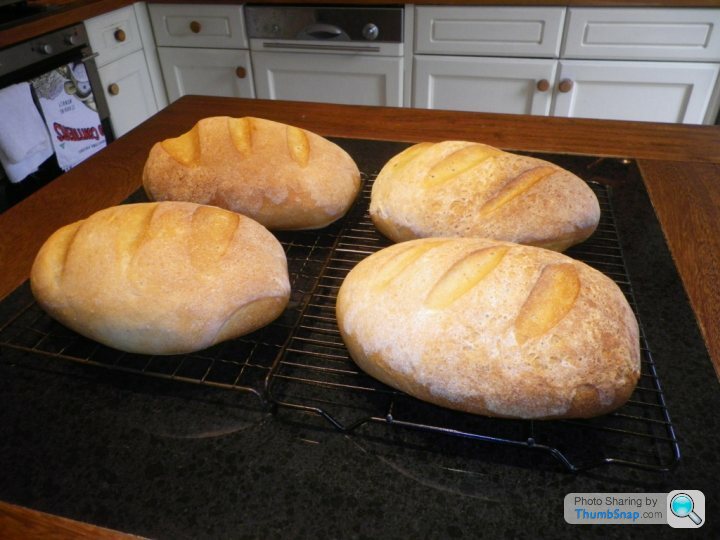
Bear in mind I probably make larger quantities than most: i.e. 1.5kg flour, almost 1 1itre starter, around 1 litre water etc, and a big batch takes a bit longer to prove than a small one....
My timings:
I usually start my bread mix before I got to bed. All of the flour, oil and salt in. All of the starter in
Half the water in. Then stir in the bowl with a big wooden spoon, gradually trickling more water in until most of the dry flour is mixed (I dont always need all of the water, depending on humidity etc, but the amount you will require in yours will come with practice). I then knead the mix in the bowl for a few minutes before turning out on the floured worktop, and kneading for about another 10 minutes, adding very small amounts of flour as required until it no longer sticks to my hands or the worktop.
I then leave overnight to rise enough to be ready for knocking back and shaping (bit tricky in the summer cos it could takes only 4/5 hours before it's escaping out the bowl, so I have to be prepared to check it around 5am. Winter is a bit more relaxed as it can take 6 or 7 hours to be ready for shaping.
So once shaped and on the trays, depending on kitchen temperature, it will have risen back up and be ready for the oven in between 2 and 4 hours.
So thats total proving/rising time of between 7 and 11 hours depending on kitchen temperature/time of year. Add on (say) another hour for the mixing, tin greasing, oven time, etc gives you a max time of 12 hours from starting off to turning out the finished loaves. And if you are working with smaller quantities, as mentioned earlier, 1st prove times will be quicker.
PS if I'm making pizza, at the point when I shape the loaves, I hive off a lump of the dough in an oiled polybag in the fridge, and then take it out of the fridge about an hour before we want the pizza, flatten it out, add the sauce, filling, cheese etc, then once its back up to room temp and risen its ready to bake. Pizzas only take about 10 minutes to bake. Hope this helps!

Gassing Station | Food, Drink & Restaurants | Top of Page | What's New | My Stuff




